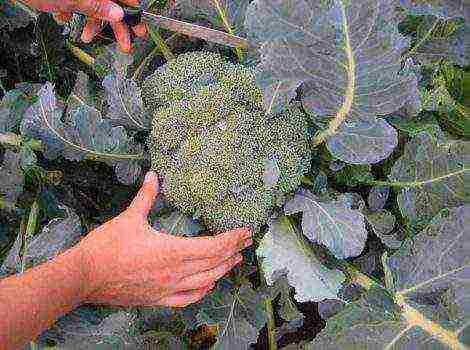Content
- 1 Early raspberry varieties
- 2 Mid-season varieties
- 3 Late ripening varieties
- 4 Repaired plants
- 5 Yellow raspberry
- 6 Black varieties
- 7 The best varieties of red early raspberries
- 8 What are the most productive varieties of late raspberries
- 9 The best new varieties of large-fruited remontant raspberries
- 10 What are the varieties of yellow raspberries
- 11 Bryansk marvel
- 12 Hercules
- 13 Hussar
- 14 Yellow giant
- 15 Giant
- 16 The most popular raspberry varieties
- 17 Raspberry remontant. The best varieties
All gardeners - professionals and amateurs are attracted by the large-fruited, high-yielding raspberry varieties and certainly with a delicious aroma and taste.
In Russia, this can be achieved by observing the rules of planting and care. From the proposed material, you can get acquainted with raspberry varieties with photographs and descriptions that are distinguished by good yield, taste, winter hardiness and resistance to diseases and pests.
You need to know that the planting material is selected taking into account personal preferences, as well as the climatic conditions of a particular area.
Early raspberry varieties
There are many early types of raspberries, it is impossible and unnecessary to pay attention to each of them in one article.
Consider several varieties of frost-resistant, well-established in the middle lane. Of course, the most interesting are high-yielding, large-fruited, resistant to diseases, pests and drought.
Here are brief characteristics of early raspberry varieties with descriptions and photographs: Here are the traditional raspberry varieties - the "raspberry" color. About the ripening time of yellow, black, and remontant varieties - information in the relevant sections of the article.
So:
Bryansk cascade
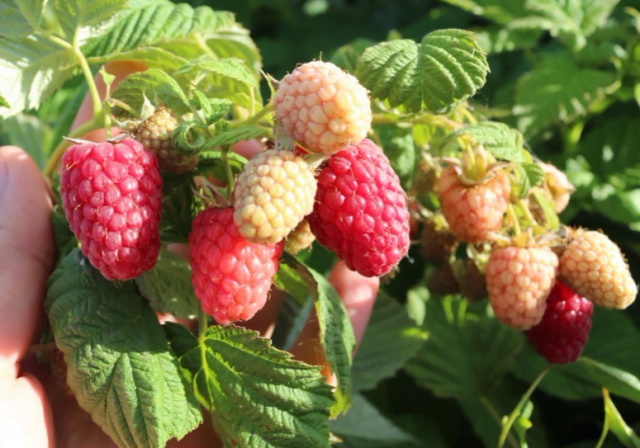
Medium spreading bushes of medium height also give berries of medium weight - up to 2.5 g of a blunt rounded shape (pictured above).
The variety does not require special care, but the yield is good, with a standard planting scheme - up to 1 kilogram per 1 m2.
Balm

Shoots up to 2 meters high with a waxy bloom, low prickly, berries weighing 2.5-3g, dark shade. Yields a yield of 0.6-0.8 kg per 1m2. The variety is not afraid of spider mites and purple spot.
Novokitaevskaya
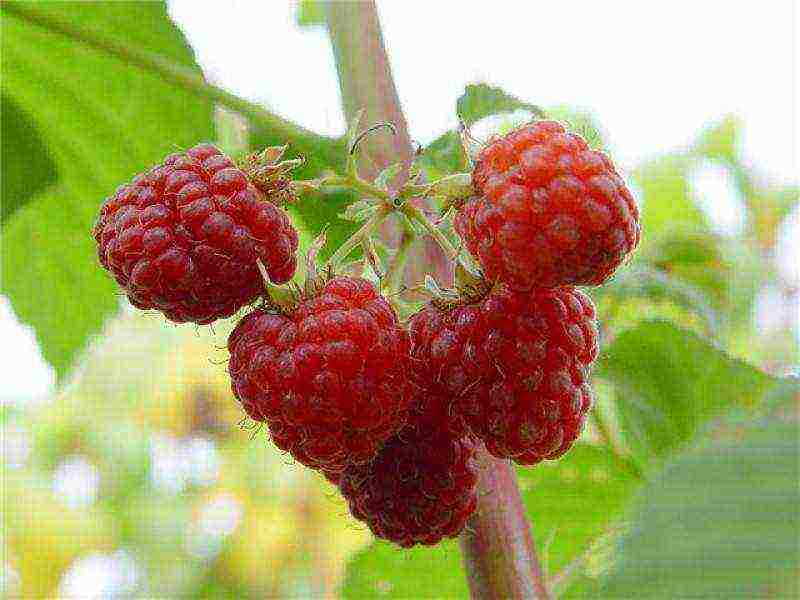
The variety was entered in the State Register in 1974, obtained by crossing the varieties Kitaevskaya and Novost Kuzmina. If you pay due attention to Novokitaevskaya raspberries on your site, then the yield can be raised to 4 kg from one bush. Blunt-pointed berries weighing up to 2.5 g have good consumer qualities.
Meteor
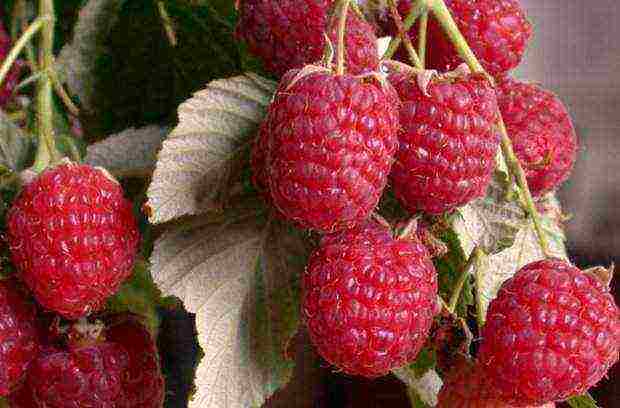
The early variety among the early ones, obtained by crossing the raspberries Kostinbrodskaya and Novost Kuzmina. Berries weighing up to 3g. Harvest from one bush - 1.5-3 kg of sweet and sour fruits. Resistant to raspberry mites and major fungal diseases, and from spider mites requires timely protection.
Mid-season varieties
Gardeners have the same wishes (or requirements) for raspberry varieties of medium ripening periods as for everyone else - high yield, frost resistance, etc.
The average ripening period of raspberries is a rather loose concept, because the same variety can be planted in different climatic conditions - this is, firstly.
Secondly, summer weather in any year can bring its own surprises, which can "shift" the ripening phase of berries according to the "usual" timing.
Thirdly, the agricultural technology used, the wishes and capabilities of the gardener - can also affect the timing of fruiting. In a word, as in the famous funny book - the rescue of drowning people, the work of the drowning people themselves.
While early varieties of raspberries usually satisfy appetite, mid-ripening berries are mostly processed into compotes and jams.
These are the following varieties that provide good yields:
Reward
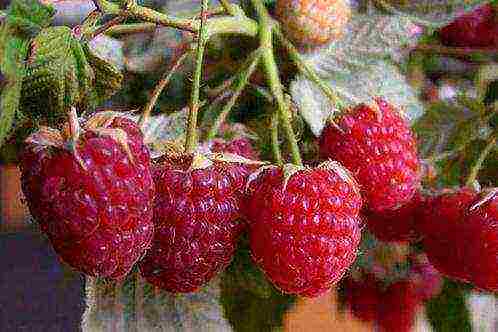
Tall bushes that do not require garters on trellises yield up to 3 kg of tasty, sweet and sour, blunt-pointed fruits weighing up to 3.5 g; The variety was obtained in the early 70s by crossing raspberries Kolkhoznitsa and Lloyd George, and is still loved by gardeners in the middle lane.
Balm
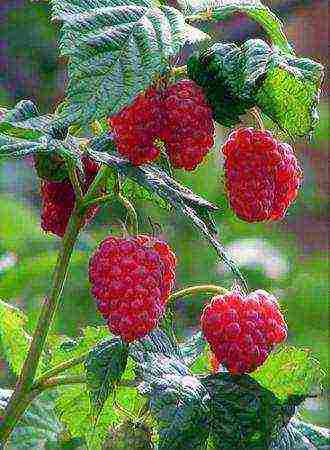
Ideal berry (2.5-2.8 g) for homemade preparations. Shoots reach a height of 1.8 m, their yield is higher than average - 2.2 kg from a bush. Derived from Newburgh and Rubin Bulgarian varieties. Good winter hardiness. The variety is included in the State Register of most Russian regions.
Zorenka Altai
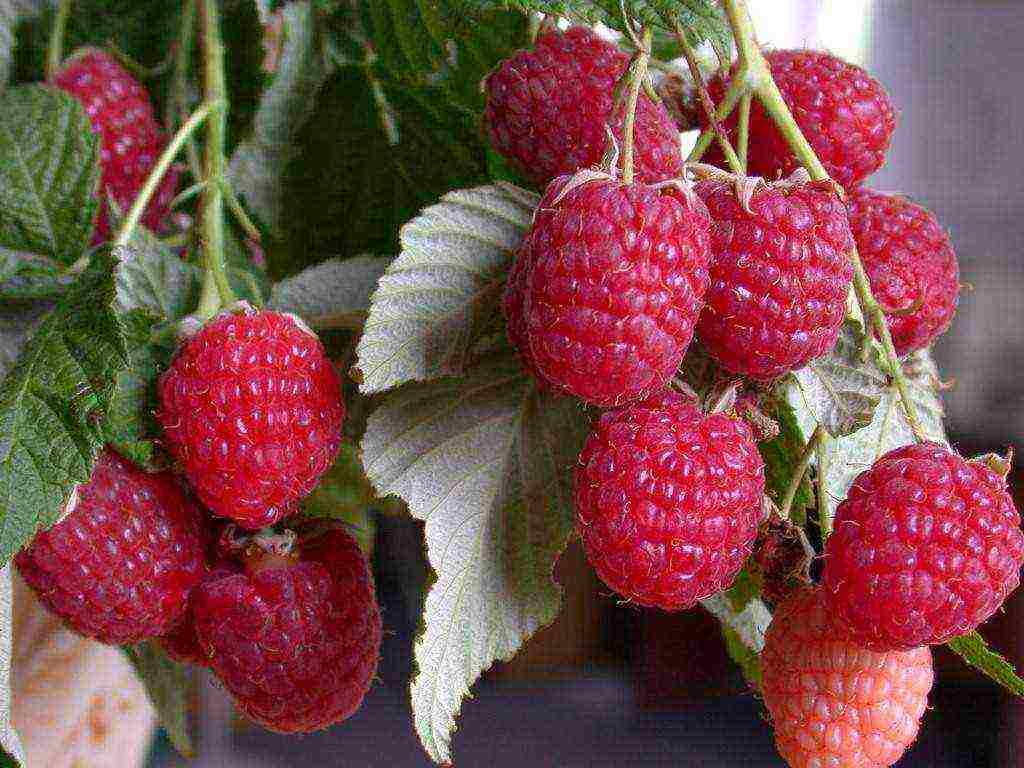
It is characterized by a sweet-sour taste of berries weighing up to 3 g. A tall, medium-spreading bush does not have a high yield. The originator of the variety is the Siberian Research Institute of Horticulture. The variety is obtained by natural pollination of wild berries and Viking raspberries.
Shy

Erect shoots of low "growth" tolerate frosts well, but react painfully to drought. Conical berries, weighing up to 3 g, dark shade, with a weak aroma, yield 2.2 kg per bush. The "parents" of the Shy ones are the Ottawa and Rubin varieties.
Giant
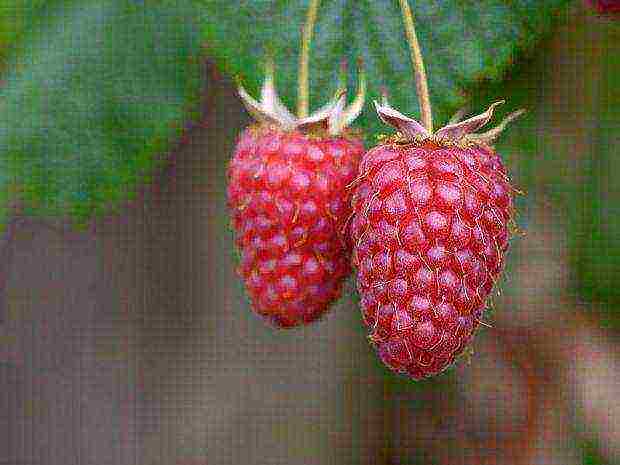
The name of the variety speaks of large fruits (up to 18 g) and high yield - 5-6 kg of sweet and sour, oblong, dense berries can be removed from the bush. The variety is also called the Pride of Russia, and it justifies itself. In the northern region, it is recommended to cover the shoots for the winter.
Late ripening varieties
Late varieties are good because in a peculiar way they remind of warm summer days.
These varieties completely replace remontant ones, if the gardener does not have an attachment to this type:
Brigantine
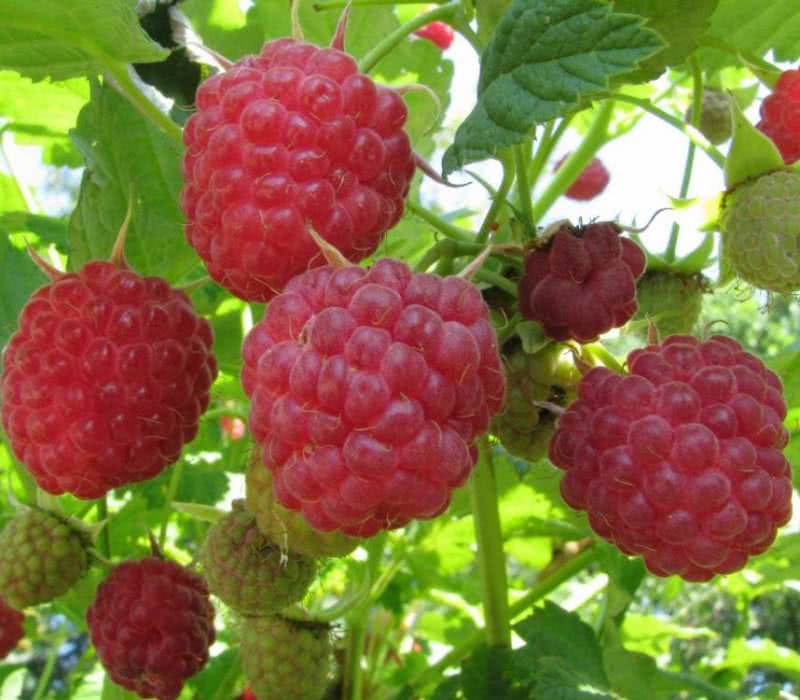
It tolerates severe frosts with sufficient snow cover. Good yield for home cultivation - 2.2 kg per plant. The berries are round, slightly conical, weighing up to 3 g, suitable for transportation. The variety was bred by crossing the Sayana and Ottawa varieties.
Mirage
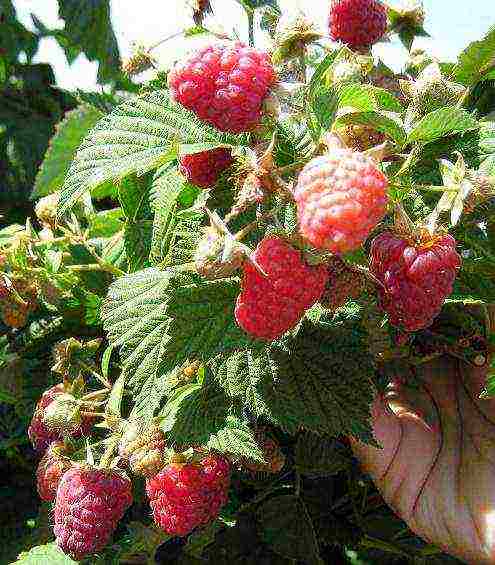
A high-yielding variety, gives 4 kg of berries weighing 5-6 g per bush, tall (up to 2.5 m), medium winter hardy, the stems with a waxy bloom are covered with thorns. High transportability of fruits.
Companion

In the fall, the attentive gardener will give up to 2 kg of dark, blunt-conical, vitamin C-rich berries weighing 2.5 - 3.0 g from one bush. The dense texture of the fruit makes them transportable. There is no wax coating on the shoots, but there are enough thorns.
Repaired plants
The advantage of the remontant type of raspberry is that it is less susceptible to diseases and pests than summer raspberries, and does not require constant chemical treatments. Repaired raspberry varieties have an increased need for sunlight and warm fertile soil. Well-lit areas are desirable for planting a remontant variety; a slight shade can significantly reduce the yield.
The success of growing remontant raspberries can be indicated by the following rule - the more heat and sun, the better. This is especially true for the Leningrad region - a territory with a transitional continental to maritime climate.
To plant raspberries, you need to select places protected by buildings, bushes, trees from cold northern winds.
Before laying the raspberry tree, it will not be superfluous to conduct a competent analysis of the soil in a specific area.
In the North-West of Russia, high-yielding remontant varieties have proven themselves well:
Unattainable

The berries ripen before the start of frost - in mid-September. Their weight is from 3 to 6 g, dark red, uniform, medium density. Fruits with a delicate "raspberry" aroma, few seeds, perfectly removable from the fruit-bearing, transportable. The average yield per bush is 2.5-3 kg, but it can be doubled with careful care. Ripening - from early August to mid-September.
Kalashnik
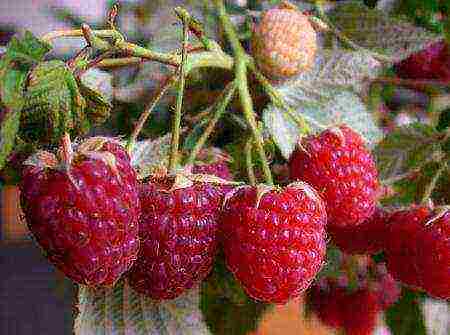
The characteristics of the variety are almost the same as the Inaccessible Raspberry. Plants up to 2 meters high, powerful, spreading, form up to 12 replacement shoots and up to 10 root suckers.Productivity - more than 2 kg of berries weighing 3.5 g;
The yellow Orange miracle also belongs to the remontant varieties, which will be mentioned below.
Yellow raspberry
In the middle lane, the berry is not as popular as the traditional red one, although the cultivation methods are the same as the agricultural techniques of the scarlet's relative. Many gardeners argue that the taste of yellow raspberries is even higher, but as they say: to taste and color. ... This type of raspberry is used in landscape design - the bushes lend themselves well to molding and grow "in moderation."
Advantages:
- Diet product.
- Useful for people with allergies.
- A good combination of sugars and acids.
- Blanks from yellow raspberry are obtained with excellent color.
- Yellow berry varieties tolerate cold weather better.
- This species does not ripen at the same time - the period of fresh consumption is rather long.
There are also disadvantages - low transportability, unsuitability for winemaking and freezing for long-term storage.
Gardeners unanimously call the best varieties of yellow raspberries of the middle lane:
Yellow giant
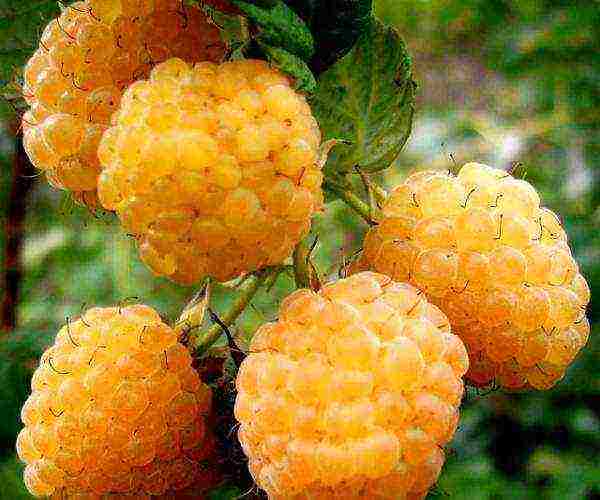
Fruits weighing up to 3.5 g, high-yielding variety (up to 10 kg per bush), disease-resistant, slightly frost-resistant. Shoots grow up to 2.5 m, in winter they need shelter under the snow.
Orange miracle
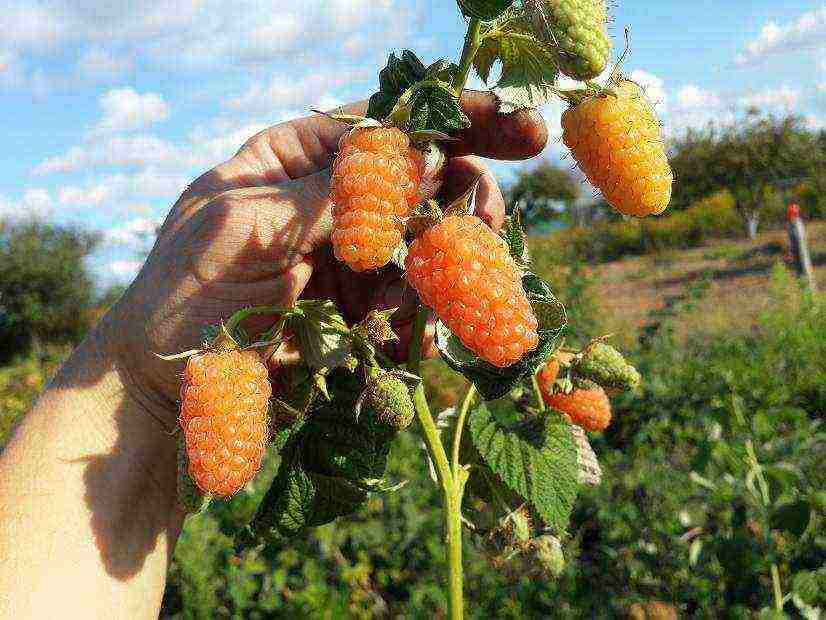
The name of the remontant variety is true. Long and dense, weighing up to 6g, berries are perfectly transported, more than 2 kilograms of berries are removed from one small bush with many thorns. It is recommended to tie the plant up.
Runaway

Medium height, up to 2 meters, slightly spreading bush, straight shoots, almost no thorns. Berries of apricot color, weighing up to 3 g, have a delicate aroma and taste. The yield of the variety is 2.5 kg from one plant. The disadvantage is poor transportability.
Golden autumn

Repaired large-fruited (up to 7g), beautifully shaped, dense, with a delicate raspberry aroma. The name "Golden Autumn"? In the Leningrad region, the autumn harvest from a bush is 2.5-3 kg.
Black varieties
This type of raspberry is less common in the Middle lane due to its dubious frost resistance. However, experienced gardeners claim that by paying a little more attention to black raspberries, they will reward them with a bountiful harvest, much more significant than traditional varieties.
In appearance and description, the berry is similar to a blackberry. It is easy to check which plant it belongs to. If it comes off with a receptacle - blackberry. The receptacle remained on the bush - raspberries.
Black raspberry bushes are decorative, during ripening they are strewn with berries of red, pink, black color, serve as an excellent decoration for a garden plot or a flower bed.
Northwest growers prefer the American-bred Cumberland, which looks little different from other black varieties. Its peculiarity is its ability to reproduce vegetatively.
Other recognized middle lane varieties are:
Ember
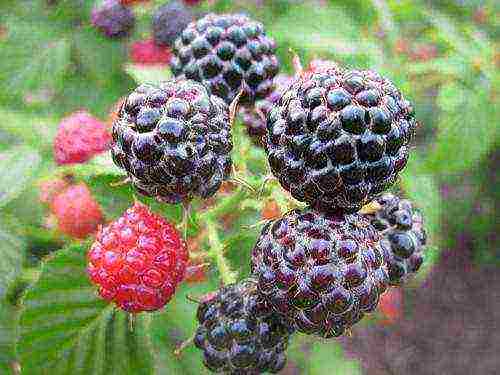
Early, with firm and sweet pulp, high-yielding, berries weighing 2 g. It tolerates frost well, is not afraid of diseases and insects. Productivity in the range of 1.5 - 2.0 kg per plant;
Airlie Cumberland
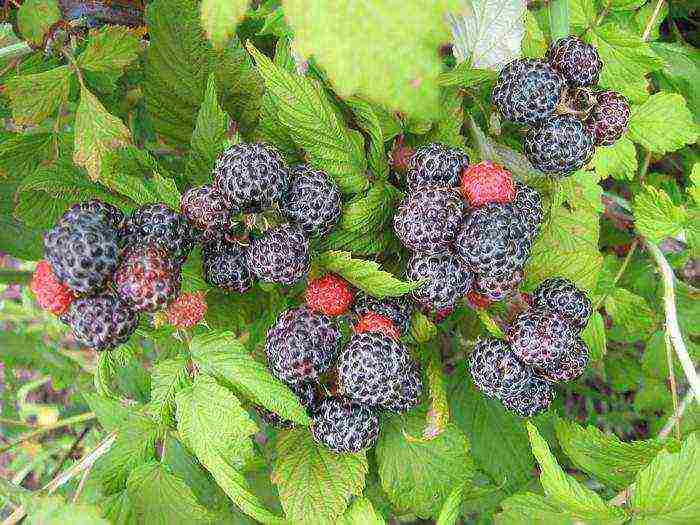
Early maturing, similar to Cumberland in many ways. Berries are black, weighing 1.6 g of a sugary sweet taste, they are not pecked by birds. The yield is high;
Bristol

A late variety of black raspberries, considered one of the best varieties, large-fruited, sweet berries, recognized by our gardeners as high-yielding. The disadvantage is that it does not tolerate winter cold.
Among them, gardeners can choose the best to their taste: early or late, high-yielding or remontant, with berries of red, yellow and even black. Find out which raspberry varieties are most popular in hobby gardening.
The best varieties of red early raspberries
"Balm". Slightly spreading bush, medium height, medium shoot-forming ability. The berries of this early raspberry variety are conical, dark raspberry with slight pubescence, sweet and sour taste with aroma.
"Modest". The bush is medium, slightly spreading. Berries are hemispherical, dark raspberry color, sweet and sour taste, no aroma.
"Companion". The bush is erect, high. The berries of this are one of the earliest varieties of hemispherical raspberries, dark raspberry color, sweet and sour taste.
"Crane". Variety of medium early ripening, remontant. Slightly spreading bush, erect, powerful shoots. Berries are large, conical, raspberry, sweet and sour taste with aroma.
"Hussar". The bush is tall, powerful, does not need support, there is little overgrowth. This is one of the best early raspberries with elongated ruby red berries, sweet and sour taste and amazing aroma.
"Sun". The berries are large, rounded-conical, crimson in color with delicate fragrant pulp.
"Patricia" - the most interesting among large-fruited raspberry varieties with attractive, beautiful berries. The berries are large, individual up to 14 g, truncated-conical in shape, with a beautiful velvety surface, of medium density, they are removed from the fruit plant without breaking, when fully ripe they do not crumble for a long time. The taste of berries is sweet with a pleasant "raspberry" aroma, juicy melting pulp and a few small seeds. Productivity of 4-5 kg per bush. Fruiting annually, early ripening variety. One of the most productive varieties. Plants are medium-sized (up to 1.8 m), non-repaired, semi-sprawling, annually form 6-10 replacement shoots and 5-7 root suckers.
"Maroseyka" - the first domestic thornless variety with very large berries (up to 12 g) and high yield (4-5 kg per bush). Some of the red berries of this raspberry variety are double, conical. The taste of berries is sweet with a pleasant aroma. Fruiting annually, medium-early ripening variety. Bushes about 1.5 m tall, spreading, powerfully developed, not repaired.
"Aboriginal" - an early variety for areas of the non-chernozem zone. Differs in a high yield, large (4-8 g) bright red berries. The berries are conical, well-formed, easily removed from the fruit-bearing.
What are the most productive varieties of late raspberries
Below it is described which varieties of late raspberries are the most productive, and therefore are the most popular.
"Brigantine". Berries are dark raspberry, dense, round-conical in shape, good taste.
"Tarusa" - the first domestic variety with standard-type shoots, strongly thickened, hard and tough. Bushes practically do not require supports, but still the harvest is better obtained with a trellis. The berries of this fruitful variety of raspberries are large (up to 12 g), blunt-conical, bright red in color, shiny, well removed from the fruit-bearing. The berry taste is sweet with a pleasant raspberry aroma. Productivity of 3-4 kg per bush. The bushes of this variety are of medium height (about 1.5 m), compressed type, powerfully developed, non-repairable, form 8-10 replacement shoots and 4-5 root suckers each, do not creep over the site.
"Arbat" - among the new large-fruited varieties of raspberries, it stands out for the abundance of very large berries with a mass of 15-18 g and more. The berries are elongated and conical, dark red in color, shiny, removed from the fruit plant without breaking. The taste of berries is sweet with a pleasant raspberry aroma, juicy melting pulp. Productivity - up to 9 kg per bush. Plants of this one of the most productive varieties of raspberries are medium-sized (1.5-2, Ohm in height), spreading, powerfully developed, non-repairable.
"Hercules". This variety of raspberries has a medium-sized and slightly spreading bush, shoots are strong, upright, you can do without trellises when growing. Annual shoots are green in spring, and by autumn they acquire a purple hue with a waxy bloom. The thorns are hard, thin and prickly. Autumn harvest in the middle lane reaches 1.5 kg per bush. The first fruits appear on the bushes in early August. Fruiting lasts until the first frost. The fruits of this variety are very large, the average weight of one berry is 5 g, the maximum reaches 10 g. The berries have a truncated-conical shape. The color of the berry is ruby, the taste is sweet and sour.
"Daughter of Hercules". A high-yielding variety with very large tasty berries, weighing 8-10 g. Some berries reach a weight of 20 g.
As you can see in the photo, this stock of raspberries has berries of an elongated-blunt-conical shape, dense, well-transportable:
The bush is medium-sized, the shoots are highly branched. Requires little support.
"Firebird". Large-fruited, high-yielding variety with bright red berries. A distinctive feature is high drought resistance and heat resistance.
"Calendar". This variety is sometimes called the "raspberry tree" for its powerful shoots and bush as a whole. Do not creep over the site. Recommended for growing in all horticultural zones of the European part of Russia.
"Beauty of Russia". It bears fruit with a very tasty berry and has a medium-early ripening period. Berry weighing up to 12 g. This one of the best varieties of raspberries has a smooth trunk and bears fruit well in a sunny area, does not like thickening. Highly productive with good care. These berries can not only be eaten from the bush, they can be admired.
"Stolichnaya" - a late variety of raspberries, high-yielding, distinguished by powerful shoots without thorns. The berries are large (4-8 g), homogeneous, well removed from the fruit plant. When ripe, 3-4 days do not crumble.
The best new varieties of large-fruited remontant raspberries
Here you can find photos and descriptions of remontant type raspberry varieties.
"Indian summer". The first domestic cultivar of remontant raspberry with predominant fruiting on annual shoots.
"Apricot". Amber fruits with a pink blush have an apricot flavor. Such amazing berries delight not only children, but also seasoned adults. This raspberry begins to ripen in August and bears fruit until frost. During the summer-autumn period of fruiting, gardeners manage to collect up to 4 kg of berries. Semi-spreading bushes, medium height. Thorns are located mainly in the lower part of the shoots, so they do not interfere with caring for the plant and harvesting at all.
"Bryansk Marvel". The variety of this raspberry has a medium-sized and compact bush, which reaches a height of 1.6 m. Fruiting is abundant, fruits are large, up to 6 g. The berries have a graceful elongated-conical shape with a pleasant taste and delicate aroma. They separate well from the stalk. Up to 5 kg of raspberries are harvested from the bush. The first crop is harvested in July, and the second - from mid-August until the first frost.
"Taganka" - early variety, high-yielding, large-fruited. Numerous thorns on the shoots. The berries are large (4-8 g), conical. The grade is remontant. The berries of the autumn harvest are also very large (up to 6 g).
"Kalashnik" - a remontant variety, which is used exclusively for obtaining an autumn harvest.
"Pride of Russia". This one of the best varieties of remontant raspberries is distinguished by its large and attractive berries. Weight reaches 12 g, individual berries can reach 18 g. Fruits have a conical and blunt-conical shape with a velvety surface. The berries are easily removed from the stalk and, when fully ripe, do not crumble.
The taste is sweet, light and pleasant aroma. The berries are juicy and have small seeds. Up to 5 kg of fruits are harvested from each bush. Bears fruit every year. The variety ripens on July 8-10, therefore it is considered medium early. The bush of this variety is medium-sized and compact. The variety is not remontant.
"Cap of Monomakh". The variety is remontant, has a low bush in the form of a small tree, which forms several slightly drooping, highly branched shoots. The variety is distinguished by large fruits (up to 7 g) of ruby color, elongated blunt-conical shape. The berries come off well from the stalk, ripen in mid-August and bear fruit for a long time. You can collect 5.5 kg of berries from a bush. However, before the first frost, not all berries have time to ripen. The first crop is harvested in July, the second from mid-August until the first frost.
"Giant" considered one of the best varieties for cultivation in summer cottages.This is a new variety of raspberries that has a distinctive feature: it lacks thorns. The weight of the fruits of this one of the best varieties of large-fruited raspberries can be 25 g. The yield of one bush reaches 12 kg, of course, subject to all the rules of agricultural technology.
Atlant - one of the best varieties of remontant raspberries with very tasty and aromatic berries. Moreover, even cold and rainy weather does not negatively affect the taste of the berries. The first berries ripen in mid-August, and then the yield goes very quickly. By mid-September, up to 5 kg of fruit can be harvested from one bush with good care.
"August miracle" - remontant raspberry variety forms a low compact bush, consisting of 7-8 upright shoots. The berries are formed almost along the entire length of the shoot, large, weighing up to 4 g, excellent taste with a delicate aroma. High productivity - 4 kg per bush.
"Penguin". The variety got its name for the standard type of bush. Strong shoots with shortened internodes, does not require additional support (bush height 1.1-1.4 m). The variety is remontant, productive, one of the earliest ripening, until mid-September the harvest has time to ripen completely. The berries are large, 6-8 g, round-conical, dark crimson. After ripening, they can hang on the bush for 5-6 days without decaying.
"Eurasia". A variety with a ripening period in the first decade of August. Large berries with good taste. Raspberry-like fruiting of medium vigor.
What are the varieties of yellow raspberries
"Orange miracle". This remontant variety has large berries (10-12 g) of golden yellow color and elongated conical shape. The bush reaches a height of 1.6 meters. The thorns are soft and short. The bush of this yellow raspberry variety does not require support. The variety is high-yielding, which is usually not characteristic of yellow-fruited varieties.
"Golden autumn". Large-fruited, remontant variety with bright golden yellow berries. The berries are large, 5-7 g, individual up to 11 g, beautiful, elongated-conical, dense. Dessert-flavored berries with a persistent raspberry aroma. The yield is high. Resistant to diseases and pests.
"Yellow Miracle". Exceptionally productive remont variety, with large (6-8 g) yellow berries, Good dessert taste. The variety is vigorous, the shoots are thick and strong, but requires support. Differs in late onset of autumn fruiting (first decade of September). It is best used as a variety combining summer and autumn harvests.
"Yellow giant" considered the largest among all raspberry varieties. The sweet fruit reaches the size of a walnut. The bushes grow crowded, up to 2.5 m in height. In the fall, the upper part of each shoot is cut off at a height of two meters. With this technique, you can achieve the formation of larger fruits. The shoots are strengthened on a trellis.
Now watch the video "Raspberry Varieties" to get a better idea of what shrubs and berries look like:
Raspberry is a recognized leader among horticultural crops. Over the long years of her selection, it was possible to bring out high-yielding and unpretentious varieties that have won the love of many summer residents. Want to know more about the preferred varieties?
Raspberries are loved and appreciated for their excellent delicate taste and indescribable aroma of the fruit. Information about the first varieties of raspberries in Russia dates back to the 19th century, and since then gardeners and breeders have been tirelessly working on the creation of new varieties. Let's find out which varieties of raspberries are recognized as the most productive and are guaranteed to give an abundance of berries during the season.
Bryansk marvel
A prestigious remontant variety that begins to bear fruit already in the year of planting. The plant tolerates drought and temperature extremes very well. Berries ripen dense, large, elongated conical shape, saturated red. You will never see wormy ones among them, since the Bryansk diva is not afraid of raspberry beetles and weevils.To make the raspberries grow large, remove the branches with buds at the bottom of the bush until they bloom.
| Appointment | Productivity (kg per bush) | Berry weight (g) | Maturation (period) | Bush height (m) | |
|
4-5 |
6-10 |
1,5-2 |
From mid-August until the first frost |
||
Hercules
Hercules raspberries are sometimes called the "queen of the garden." The bushes are strong, not spreading, erect, do not bend under the weight of the harvest and do not require a garter to the trellis. The plant is rarely attacked by pests and is almost not prone to diseases of gray mold and fungal infection. The berries ripen large, pale burgundy. They are very succulent, so they are best eaten straight from the bush. However, this raspberry jam will suit everyone's taste.
| Appointment | Productivity (kg per bush) | Berry weight (g) | Bush height (m) | Maturation (period) | |
|
3-4 |
9-15 |
1,5-2 |
From mid-August until the first frost |
||
Hussar
This is one of the "golden varieties" of Russian selection, distinguished by unpretentiousness and simple agricultural technology. The plant is also recommended to grow in the southern regions. The berries are large, elongated, with a blunt end. Their color during the ripening period approaches dark ruby. The pulp of the berries is dense, they hardly rot and tolerate long-term storage and transportation well.
| Appointment | Productivity (kg per bush) | Berry weight (g) | Bush height (m) | Maturation (period) | |
|
5-6 |
4-6 |
1,8-2,5 |
Early July - August |
||
Yellow giant
This variety is loved not only for its abundant fruiting and sweet taste of berries, but also for its decorative properties. The bushes are not afraid of frost and common raspberry diseases. It is impossible to store yellow berries for a long time, it is better to eat them fresh, freeze or immediately start up for processing.
| Appointment | Productivity (kg per bush) | Berry weight (g) | Bush height (m) | Maturation (period) | |
|
4-6 |
4-8 |
2,2-2,5 |
Mid July - Mid Autumn |
||
Giant
It is believed that this variety is best suited for summer cottages. The bushes are completely devoid of thorns. The berries have a pleasant taste and aroma of real forest raspberries, they are very juicy and sweet. The plant is not susceptible to attack by aphids and diseases, and also tolerates frost well. Over time, the berries begin to shrink and become similar to regular raspberries. In this case, it is better to plant new bushes.
| Appointment | Productivity (kg per bush) | Berry weight (g) | Bush height (m) | Maturation (period) | |
|
6-10 |
8-14 |
1,2-1,8 |
Mid July - end of August |
||
Choose, compare, experiment! And you will certainly grow raspberry bushes, densely covered with large fragrant berries. Share your impressions and experiences on our forum.
When growing raspberries, each summer resident takes into account many factors that affect productivity. But in order to obtain a high yield, in addition to providing optimal conditions for active growth, it is necessary to select the best varieties of raspberries. It is advisable to choose planting material in accordance with climatic and regional conditions, and it is also necessary to carefully study the properties of each selected variety.
Today, in specialized stores, in spontaneous markets, in gardening enterprises, you can see a large number of seedlings. But you should pay attention to the fact that the varieties are divided into categories of cold resistance. More thermophilic raspberries will not yield crops in colder regions, even under greenhouse conditions. What popular varieties of raspberries are recommended by summer residents and gardeners for growing in a particular region?
The most popular raspberry varieties
The hearts of most gardeners and gardeners are conquered by medium varieties. They are considered versatile and can produce an average yield and bear fruit under moderate conditions, withstanding even slight cold. As summer residents note, such a raspberry fully satisfies human needs. Popular varieties of this garden plant:
- Canadian. Very sweet raspberry. Differs in a complete absence of acidity. Her berries are small, but very tasty. Each of them weighs about 9 grams.The plant itself is tall, and can reach up to 2 m in height. For one season, it can give about 7-9 kg. ripe fruits. The Canadian raspberry loves moisture, but its resistance to obedient climatic conditions is also listed among the properties. Does not require special care - everything is according to the standard.
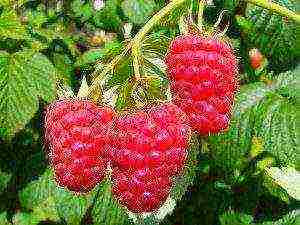
- Aboriginal. You can safely classify the best early raspberry varieties. The berry was bred by Russian breeders and is recommended for growing in moderate conditions. It does not tolerate cold well, but at the same time it can independently recover in a year by means of new shoots. The fruits of the Aboriginal variety are not large and weigh about 5 g. Large berries can weigh up to 8-9 g. The bush is defined as medium-sized and does not exceed one and a half meters in height. For the season, it can give up to 6 kg. A remarkable property of the variety is that it is practically not affected by pests and diseases.

- Faith. Another sweet variety of raspberries. The best varieties in terms of taste are the category to which these berries belong. Productivity from one bush is not less than 4.5 kg. The bush grows no more than 1.5 m and gives small berries up to 4 grams. Loves moisture very much, so it should be watered thoroughly. Among the main properties is also conditional resistance to heat and extreme cold.
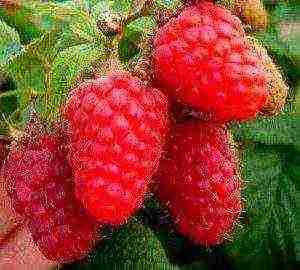
- Meteor. The earliest variety of raspberries among the versatile. The berries ripen in early July almost simultaneously (up to 3 grams. Each. They have a pronounced cone-shaped ruby color. The bush is powerful, low up to 1.2 m. It has resistance to diseases and, relative to other varieties of raspberries, Meteor is frost-resistant. Productivity - 2 kg / bush The taste and aroma will always delight the summer resident. All this is quite enough to open the raspberry season.

- Alyonushka. If at the stage of selecting varieties for a summer residence there is a question about which varieties of raspberries are better to choose, many advise Alenushka. This is one of the most productive varieties. Up to 13 kg / season are harvested from this plant. As for the taste, there is a slight sourness in them. At the stage of ripeness, this is not noticed, but in the process of making the jam, you need to add extra pounds of sugar. But this cannot be considered a disadvantage. Alyonushka raspberry bush can reach up to 2.5 m in height. The growing process of this raspberry requires a garter to the trellis or supports. It should be noted that the variety is resistant to many unfavorable conditions, including frosts, it does not have any problems.

In addition to the above varieties of raspberries, there are also two varieties that I would like to note: Marlboro and Taganka. In terms of properties and productivity, the Marlboro raspberry is not inferior to the Alenushka variety, and the Taganka raspberry is the best late variety. It can withstand frosts down to -20C and more.
Raspberry remontant. The best varieties
What is a remontant raspberry? It differs in that the crop can be harvested from the first year of planting seedlings in the soil. This advantage is especially important for those who are engaged in the cultivation of raspberries in order to improve their financial situation (as a business). Getting a quick result in a short time is the main goal of summer residents-entrepreneurs. For summer residents who grow berries for themselves, this advantage is also important, but the amateur summer cottage business requires thoroughness and time.
What are the best varieties of remontant raspberries that exist today:
- Shugan. It has excellent taste and large fruits. On average, up to 10 kg are harvested from one bush. harvest for the season. It is considered a high-yielding Swiss variety. The plant has a strong stem that reaches 1.6 m in height. With this growth, he does not require a garter. Among the remarkable properties, it should be noted the long-term preservation of the presentation (they do not crumple up to 4 days).

- Polka. Polish breeders also presented their raspberries. The best variety is Polka. Popular in our country. For Europeans, this is also one of the best varieties.As for the plant itself, it grows up to 1.5 m and has strong stems. The berries of this raspberry variety are quite large and have an impressive weight. At the same time, a good average yield is harvested from one bush. The peculiarity of the variety is that it can produce up to 100 shoots per 1 m2 area. This allows it to multiply quickly. The berries have a very sweet taste, the Polka raspberry variety belongs to the dessert category.
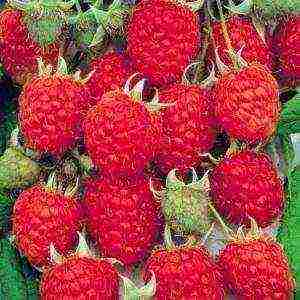
- Bryansk miracle. One of the earliest varieties. The fruits have an elongated, conical shape and excellent taste and aroma. The first berries can be eaten around the 10th of August. The yield of the variety is good. They retain their freshness and presentation well for 5-6 days. A remarkable property is its resistance to drought and frost. This is one of the best varieties of remontant raspberry for Siberia.

- Hercules. A novelty in the market of fruit and berry crops. It is a mid-season remontant variety with erect, powerful stems. The berries are round, conical in shape and have a purple hue. The taste is sweet with sourness. An average crop is harvested from the bush. The first berries can be tasted at the beginning of August. Noteworthy is the fact that the stems have large thorns and a slight waxy coating. This is its bright, distinctive feature. This variety is one of the best raspberry varieties for the Moscow region (see photo).
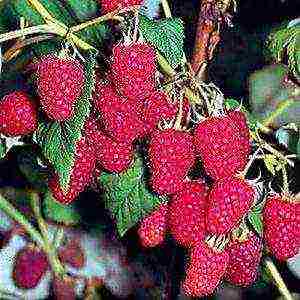
- Indian summer-2. This novelty was presented quite recently, but it has already become known among businessmen and ordinary summer residents. Due to the structure and powerful stems, the bushes of this variety do not require a garter. Most of the fruits can be eaten in the first half of September. The rest of the harvest is harvested before winter. It tolerates changeable climate conditions well, and adapts well to changeable climates.

In addition to these varieties of raspberries, there are many others: Eurasia, Monomakh's Hat, Kalashnik, Morning Dew, Apricot.
Raspberry remontant, video


